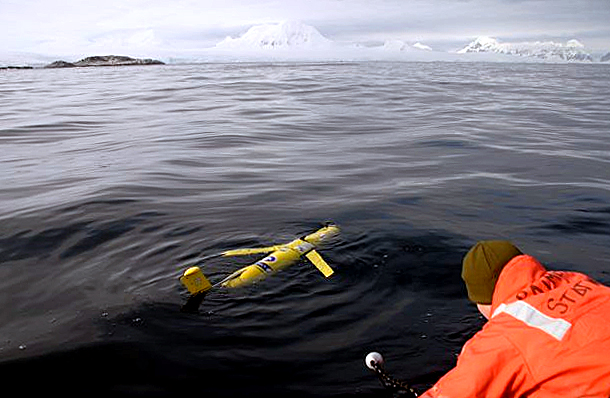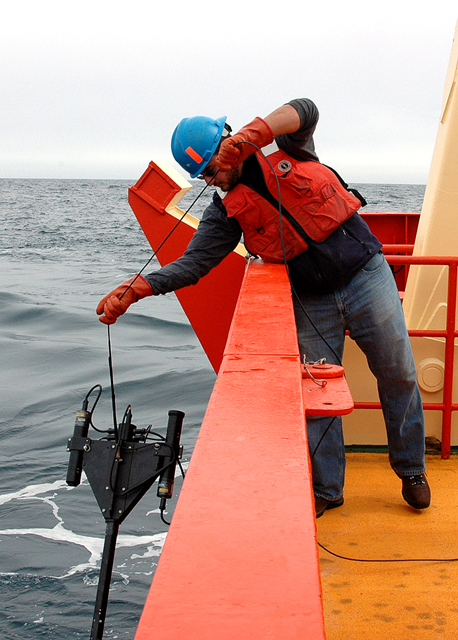A shrinking problemClimate changes shifting phytoplankton community to smaller cellsPosted June 18, 2010
The ARSV Laurence M. Gould Meanwhile, Tina Haskins is elbow-deep into the electronic guts of a Slocum glider in one of the station’s labs. A torpedo-shaped robot capable of traversing enormous stretches of the ocean, the glider is one of the newest and most important tools for the Palmer Longer Term Ecological Research (PAL LTER) Unfortunately, two of the three autonomous underwater vehicles (AUVs) that the Rutgers University Haskins is using that one for spare parts, leaving only one functional glider. While a relative bargain for the sort of workhorse oceanographic work it performs, the gliders cost $100,000 or more depending on what sensor packages it carries. “We enjoy not having them sink to the bottom of the ocean,” said Haskins while prepping the main glider for the upcoming expedition. “It’s an extreme environment down here.” This is the third year the PAL LTER program has employed the gliders, which collect basic information about the ocean, such as temperature and salinity, as well as perform more complicated measurements, depending on their instrumentation. The Rutgers group, led by Oscar Schofield For instance, the gilders were experiencing more and more leaks due to condensation because they were prepped and vacuum-sealed at room temperature, and then dropped into the frigid water. Now the gliders sit outside for 24 hours before they are vacuum-sealed, Haskins said. “It’s weird little things like that you don’t know until you’re down here,” she noted. In addition to operating the gliders, the Rutgers group oversees the phytoplankton component of the PAL LTER. These mostly microscopic organisms form the foundation of the polar food web. Marine animals called zooplankton such as krill “graze” on phytoplankton for food. In addition, phytoplankton are important in sequestering, or storing, carbon from returning to the atmosphere in the form of carbon dioxide. Since 1993, the PAL LTER program has monitored the composition and health of phytoplankton along their study area. Last year, the researchers published a paper in the journal Science suggesting that the community is shifting from larger-celled organisms such as diatoms to smaller-celled organisms like flagellates, based on their own data and satellite measurements dating back to 1979. “In the north part of the peninsula, there was a 90 percent decline in phytoplankton in response to loss of sea ice and warming in that region,” said Hugh Ducklow “Trying to get a handle on the cycling of carbon from the atmosphere to the ocean to the seafloor is a really big part of the LTER,” noted Alex Kahl Phytoplankton are important to the carbon cycle because as they die, they fall from the surface to the deeper ocean. Bigger cells sink faster, so a shift in the phytoplankton structure to smaller organisms means that carbon could stay at the surface long enough to be sent into the atmosphere as carbon dioxide, such as through microbial respiration. Aboard the ship, Kahl and the rest of the team are busy not only with handling the glider but with filtering samples of water from different stations and depths in the ocean. To collect the water a device called a CTD rosette — a cylindrical cage made of aluminum pipe with 24 long, narrow PVC bottles, like a loaded revolver chamber — is lowered into the ocean off the ship’s starboard side. Once the CTD rosette reaches a certain depth, it is winched back up. The bottles are triggered to close at 12 predetermined depths based on certain ocean properties detected by optical instruments deployed earlier in the day. Ducklow and Schofield’s teams then “milk” the machine, filling dozens of bottles for various experiments. Many of those for Schofield involve filtering water for phytoplankton samples. The scientists measure chlorophyll and pigments, which tell them about the composition of the phytoplankton. “The pigments are the equivalent of fingerprints,” Kahl explained. “Different phytoplankton have different pigments.” Other experiments test how efficient the phytoplankton are at photosynthesis, as well as how much carbon dioxide they suck out of the water. The team is also testing environmental parameters, such as the amount and wavelength of light available to phytoplankton at the surface of the ocean. “We’re basically trying to characterize the whole physical environment that affects phytoplankton, which is the basis of the food web,” said Kahl. Once under way, all the scientists work 24 hours a day, in 12-hour shifts, filtering particles out of the water samples and then returning the water back into the ocean. A keen surfer from California, Kahl sees the expedition as an important measure of the carbon cycle — and, consequently, the health of the world’s oceans. “I was under the idea that I wanted to understand this thing that I’ve been sitting in for half my life,” he said of his decision to ditch his art history major for a career in science. “The funny thing is, the more time I’ve spent studying the ocean, the less time I’ve spent surfing. That’s an unfortunate side effect.” NSF-funded research in this story: Oscar Schofield, Rutgers University, Award No. 0823101 |



For USAP Participants |
For The Public |
For Researchers and EducatorsContact UsU.S. National Science FoundationOffice of Polar Programs Geosciences Directorate 2415 Eisenhower Avenue, Suite W7100 Alexandria, VA 22314 Sign up for the NSF Office of Polar Programs newsletter and events. Feedback Form |




